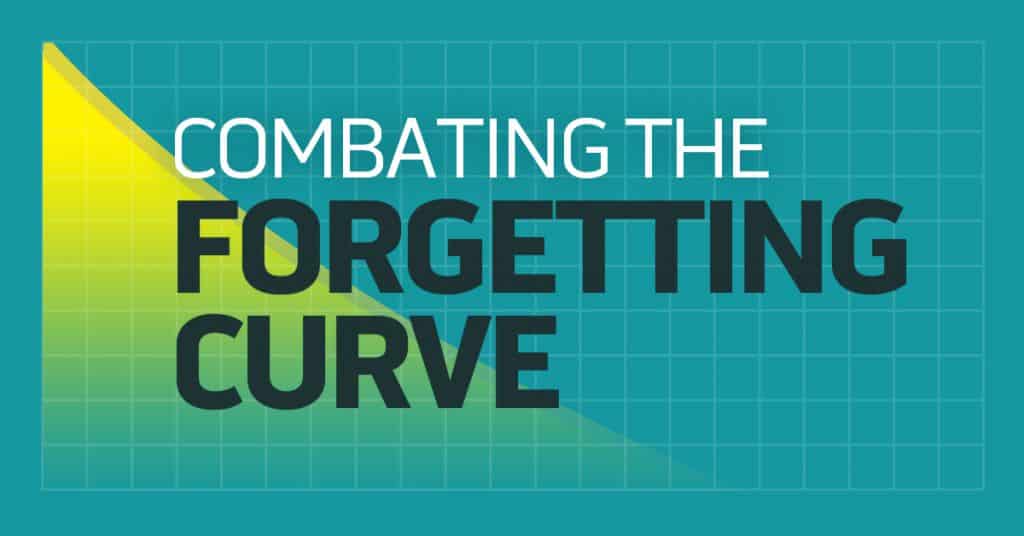August 2, 2017

Tips for Beating the Training Forgetting Curve
Industry:
Solution:

In a recent article, we introduced you to the well-documented forgetting curve in training and explained that something called spaced practice can help reduce or even eliminate the forgetting curve.
In this article, we're going to give you a few more tips for how to design training that combats the forgetting curve and creates memorable training that employees will not only understand during the training, but that they'll also remember after the training and put to use on the job.
Sounds like good stuff to know, no?
Let's get started, then.
[optin-monster slug="ols6gbrjaaaeu127bvxk"]
What Is the Forgetting Curve: A Reminder
So what's the forgetting curve, for those of you who forgot? (Ha!)
The forgetting curve is the very well-documented tendency for people to begin to forget something they learned (such as your training) almost immediately.
One result of the forgetting curve is that if you do one-and-done training, people may understand the concepts at the end of the training, remember them, and be able to pass a test that day, but that ability to pass the test is already seriously in jeopardy the next morning and those test scores are going to continue downward unless that learning is reinforced.
We have an earlier blog post that explains the forgetting curve and gives some graphs and charts if you want to review that.
In addition, you may want to check out the excellent white paper on spacing learning and the forgetting curve by Dr. Will Thalheimer. This is one of the better resources on the topic I'm aware of. Set aside a few hours, pour a refreshing glass of your favorite beverage, and take a deep dive into the concept with this one.
And this is another nice resource on the forgetting curve if you want something a little shorter than Dr. Thalheimer's magnus opus.
But to wrap this up in a bow, the basic idea is people forget training very quickly unless it's reinforced.
[optin-monster slug="cnlg8e2b5w7tl70zqmor"]
How to Design Training that Defeats the Forgetting Curve
We train people for a reason--because we want them to apply that knowledge or those skills on the job.
So the idea of training people only to have them lose that knowledge or those skills as the result of the inevitable forgetting curve should be pretty horrifying from a "wasted time, effort, and money" view and "I want my training to be effective and contribute to reaching objectives, business goals, and positively affecting KPIs" kind of way.
And so it only makes sense that we should design training that is intentionally structured to help employees remember the knowledge and/or retain the skills over time. Let's see a few simple tips how to do this.
One of the things you're going to notice in many of the suggestions below is the idea of building in "desirable difficulties" into your training. For more about desirable difficulties, we recommend you check out the book Make it Stick: The Science of Successful Learning by Brown, Roediger, and McDaniel.
Develop Training Campaigns and Learning Environments, Not Isolated Training Events
The first thing to know is that isolated training events in a one-and-done format are basically doomed to fail from the start, especially if workers don't get to put the training into practice immediately.
This is how humans and their brains work. It doesn't matter how charming and engaging you were during training, or how well-designed your visuals were, or how closely you followed and integrated adult learning principles. You can basically translate "one-and-done training" to "pull the plug on memory."
As a result, you'll want to spread learning out over time, creating training campaigns with multiple touch points. That's the point of the shorter article about the forgetting curve we linked you to earlier.
Relate New Knowledge to Prior Knowledge
Let's start with a metaphor here. If you want a seed to grow into a beautiful plant, you are going to want to put it into nice, healthy soil.
And to take that further, you may want to plow that soil up a little bit first. You know, kind of ACTIVATE it.
The same basic wisdom applies to training.
When you're teaching people new information, or trying to help them develop new skills, you want to try to relate it to information the learners already have in their brains first. And so you want to "stir up the soil" in their brains by awakening that prior knowledge before you start "planting the seeds" of new knowledge with them.
Why? Because it will make it easier for the learners to make neural connections that help that new information "stick" in their brains, meaning they'll be more likely to remember and use it later.
How? Well, there are a lot of ways to do it. One is to simply start a training session by asking the learners what they know about the topic before you begin. This is addressed a little further in our article on Gagne's Nine Events of Learning. Figurative language, including metaphors, similes, comparisons, and contrasts, help too. And another thing that helps is asking the learners to solve a problem before you teach them how to do it. That last one sounds counter-intuitive, I know. But you're going to see that's a trend here. For the time being, trust me that it works.
Just think of this as priming the pump for learning.
Use Spaced Practice for Training
Our earlier article on spaced practice and the forgetting curve calls this out in more detail, and we also addressed this above when we said one-and-done training won't cut it.
But it's important to know that coming back to training people on the same information and/or training topic at different points over time helps the person retain that information.
The basic idea behind spaced practice is to come back to a specific training topic again and again, leaving enough time for people to forget stuff before you come back. That process of learning something, forgetting, then coming back and learning it again (especially retrieving the information and/or recreating it) makes learning "stick" in the long term.
There are two basic ways to think about spaced practice. The first is during the initial, primary, or main training event, and the second is to think of the initial training event plus the training event that follows the initial one.
When you are designing that initial training session, think about coming back to the idea at multiple times within the same session--build in some repetition. Also, although I'm now stretching the meaning of the term initial training session, think about adding a pre-training assignment. For example, maybe a self-guided online course before the initial/primary training.
In addition, you should also think about building in additional training after the primary training. This is where a microlearning course can help--you don't need to have a full, one-hour session, but maybe a series of shorter session just to keep the memory alive.
Make Sure Training Includes Retrieval Practice
After the initial training, have the workers try to retrieve the information.
If the training focused on knowledge, have the learners try to call it back to mind. Name it. List it. Explain it.
If the training focused on a skill, have the learners practice and demonstrate it. And give them proper feedback, or let them see the consequences of their decisions.
Folding this form of retrieval into that spaced practice will improve retention.
One quick note: retrieval is different than recognition. So, if it's knowledge, asking the employees to repeat something in their own words or fill in a blank (both of which are forms of retrieval) is better than having them answer a multiple-choice question (which is a form of recognition).
Keep in mind that idea of a desirable difficulty--make their brains "grind" to retrieve that information.
Try Some Interleaved Practice
In common language, interleaving can be said to mean something like "shuffle it up."
Here's an example: If you do all your Haz-Com training in January and then put it away for the year, then do all your Lockout/Tagout training in February, and all your Pedestrian Safety training in March, you are not interleaving.
But if you cover Haz-Com, then Lockout, then Pedestrian Safety (in that order) in January, then come back to Haz-Com in February, Pedestrian Safety in March, and all three again in April, you're interleaving. You're shuffling topics so you come back to them, but only after you've introduced something else.
Interleaving, like retrieval, causes a desirable difficulty that improves retention. Try it and see how it works for you.
Try Some Varied Practice
This is another form of "mixing it up." With varied practice, when employees are practicing (and/or retrieving) the knowledge/skill from training, don't have them practice it in the same way every time.
So, for example, in the first spaced practice, ask them to state the information in their own words. Then the next time, do something different.
That variety adds to retention as well.
Take Advantage of the Testing Effect in Your Training
Testing is good for at least two reasons.
First, because it's a form of retrieval, and we've already mentioned that retrieval is good. That retrieval causes the learner's brain to grind and improves learning over time.
But second, because it gives the employee the chance to get an objective understanding of how well he/she is doing. It's easy to float along thinking you know something well or can do something well when the reality is that you don't. Testing is a wake-up call that can help the employee realize he/she doesn't have something mastered as well as he/she thought, or confirm that he/she does.
Here are some tips for good testing.
Add Desirable Difficulties to Training (and Teach Learners to Be Comfortable With It)
People are notoriously poor judges of how well they are learning.
For example, we already addressed this in a great detail in an earlier article about "smile sheets," the post-training evaluation forms people fill out after training. In that article, we learned that there's almost no correlation to how much people said they learned in training on smile sheets and how much they actually learned (as measured by tests). People often said they learned a lot, when they learned little, and that they learned little, when they learned a lot. They often gave high marks to training sessions that were fun, saying they learned a lot (even if they didn't), and low marks to training sessions that were less fun and/or that required more work (even if they did learn a lot).
In a similar manner, people have a tendency to switch from a difficult form of learning experience to one that seems easier, assuming that that easier one, the one that feels more comfortable, will lead to better learning.
But as you've seen, due to this idea of desirable difficulties, people often learn better when the learning experience is a little harder. And that means people have to come to realize that it's OK for training to be difficult at times, and for them to be a little uncomfortable with an apparent lack of progress or even temporary regression.
And that means that it's your job as a trainer to help support people in this process, to let them know that learning takes a little grind and a little grit, and to make them comfortable with all that. And to not always focus simply on making things easy all the time, but to build in some of these desirable difficulties we've talked about.
Check out our recorded discussion with Dr. Patti Shank on so-called desirable difficulties and deep learning.
Conclusion: Take That, Forgetting Curve--Training Doesn't Have to be Forgotten
We hope you found this article helpful.
If there's one key fact to keep in mind, it's the forgetting curve. One-time training is doomed to failure.
And acting on that, remember that spacing out training, and having workers perform desirable difficulties such as retrieval, is a great way to combat the forgetting curve.
[optin-monster slug="ey7geadahf1btflqowgn"]
Explore our software solutions designed to help your organization succeed
Request a Demo






